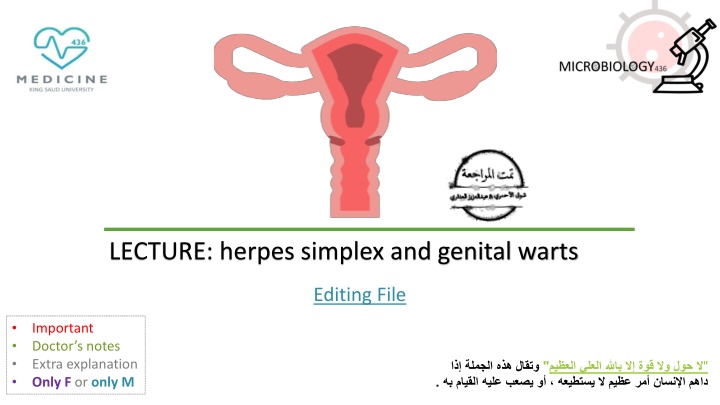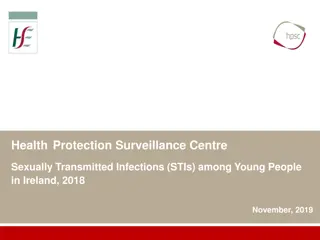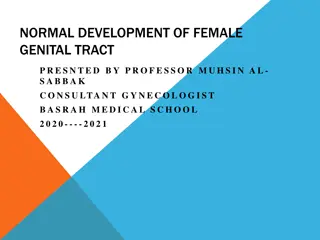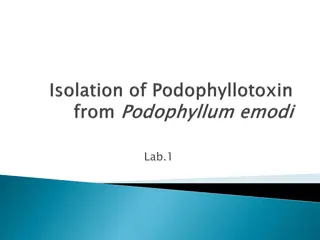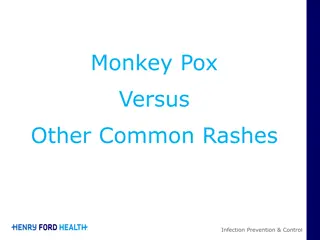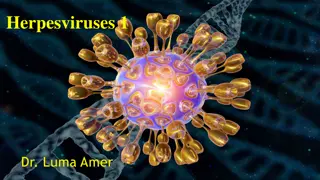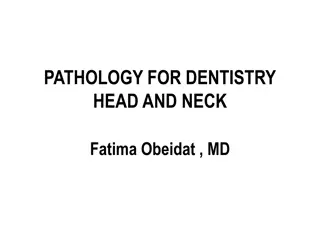LECTURE: herpes simplex and genital warts
Genital herpes and warts are sexually transmitted viral infections with distinct characteristics, modes of transmission, and risks. Learn about the etiology, characteristics, and transmission of these infections. Understand the importance of preventive measures, especially for pregnant women to prevent perinatal transmission.
Download Presentation

Please find below an Image/Link to download the presentation.
The content on the website is provided AS IS for your information and personal use only. It may not be sold, licensed, or shared on other websites without obtaining consent from the author.If you encounter any issues during the download, it is possible that the publisher has removed the file from their server.
You are allowed to download the files provided on this website for personal or commercial use, subject to the condition that they are used lawfully. All files are the property of their respective owners.
The content on the website is provided AS IS for your information and personal use only. It may not be sold, licensed, or shared on other websites without obtaining consent from the author.
E N D
Presentation Transcript
LECTURE: herpes simplex and genital warts Editing File Important Doctor s notes Extra explanation Only F or only M " " .
Introduction Introduction Genital Herpes and genital Warts are recognized as the main sexual transmitted viral infections that might be acquired by any types of sexual contact. Either normal (vaginal) , homosexual or oral sex. Risk groups: 1- Adults who have multiple sexual partners. 2- Immune compromised individuals. 3- Infants who have infected mothers. Transmitted by the mother to the child either during pregnancy or during delivery or after birth through direct contact. 4- Sexual child abuse. Genital Herpes Genital Herpes Etiology: There are two species of herpes virus capable of causing genial herpes: 1. Herpes simplex virus type 2 (HSV-2) (affects the lower part of the body, it is the main cause of genital herpes) 2. Herpes simplex virus type 1 (HSV-1) (affects the upper part of the body). 90% of genital herpes cases are due to HSV-2 infection, whereas 10% are due to HSV-1 Both (HSV-1 & HSV-2) are structurally very similar and share about 70% sequence homology.
Characteristics Of Herpes Virus : Characteristics Of Herpes Virus : Family of herpesviridae. Virion consist of: o Glycoprotein envelope o Icosahedral capsid. o Liner ds-DNA. The Herpes viruses has the ability to induce latent infection (they stay inside the person until he dies) HSV (1&2) NERVE CELLS. HSV-1 Trigeminal ganglia HSV-2 Sacral ganglia Transmission of Genital HSV infection Transmission of Genital HSV infection rare 1- Sexual transmission: o The number of different sexual partners correlates directly with acquisition of HSV-2 in both male & female. o Homosexual men are more susceptible to HSV-2 infection. Because the anus is very vascularized so the infection could spread rapidly through blood. o Genital infection can be acquired by auto-inoculation from lesions elsewhere on the body by touching vesicular fluids from any herpetic lesions (HSV-1&2). . o HSV-1 can cause genital herpes infection after oral sex, also can be seen in cases of child abuse. rare mainly
Transmission of Genital HSV infection Transmission of Genital HSV infection 2- Perinatal transmission (during delivery): o The majority of maternal infection (85%) occurs during delivery, due to direct contact between the baby and infected maternal birth canal. o The risk of perinatal transmission is usually occurred in about 50% of mothers have primary (if she gets it while she is pregnant) genital herpes, while the risk is 8% if mother have recurrent (if she has it before pregnancy) infection. o This infection can lead to either massive herpetic skin lesions or generalized infection affecting skin and internal organs e.g; lungs , liver or brain . o To avoid perinatal infection we do Caesarean section. So if a pregnant woman has a primary HSV they do C-section for her to prevent transmission to the baby, and this is the only disease which can be prevented by C-section. 3-Intrauterine(vertical) transmission (10%): o Maternal primary genital HSV-2 infection of the mother during first trimester can leads to spontaneous abortion. o Maternal primary genital HSV-2 infection which develops after 20 weeks of gestations may induce malformation as 1. Microcephally 2. Jaundice 3. Hepatosplenomegally 4. Chorioretinitis 5. Herpetic vesicles on the skin.
Pathogenesis of HSV Pathogenesis of HSV- -2 2 Genital herpes infection : o Primary infection occurs when HSV-2 infects epithelial cells covering the mucosa. o The virus then migrates to the nearest ganglion (sacral ganglia) via neurons where it replicates and establish latency for life. o Once its reactivated, it travels back through neurons to the site of the primary infection and causes recurrent infection. o Once the virus enters the human body it remains for life (latency) . Primary genital infection: Vary from asymptomatic (but most cases have symptoms) to mild or sever painful episode. If symptoms are present(I.P 2-12 days) they may include; o fever , malaise, dysuria, o Inguinal lymphadenopathy o Vesicular herpetic lesion or ulcer localized to the cervix, vagina, vulva or perineum of the female or the shaft of the penis in the male ,Herpetic proctitis (in the anal area) can be seen in homosexuals. o Aseptic meningitis have been observed in about 10% of cases as extra genital presentation.
Neonatal herpes infection Neonatal herpes infection Is not a common condition, but the mortality is >70% when it happens. It occurs during labor and delivery through the vaginal canal when a mother is having a primary active herpetic lesion and shedding the virus, also in small % as vertical transmission during pregnancy. It may spread to other organs such as lungs, liver, brain. It has three forms: Localized skin infection Localized brain infection. Generalized neonatal herpes infection. Severe massive infection of the skin accompanied with internal organs infection as lungs (pneumonia), liver (hepatosplenomegally), and brain (encephalitis) with massive skin herpetic lesions. Usually fatal limited to massive skin vesicular lesions . limited to CNS invasion causing encephalitis. mortality is high Mild infection.
Clinical picture of recurrent genital herpes. Clinical picture of recurrent genital herpes. Occurs after reactivation by environmental or physiological factors such as stress, exposure to U.V. light, menstruation, pregnancy or any condition decreased the immunity. This can be as frequent as six or more episode a year ,the attacks are milder and shorter than primary episode. Accompanied with the appearance of herpetic vesicles on the external genitalia. Symptoms may include pain and itching. Lab diagnosis Lab diagnosis 1. ELISA: serum sample is analyzed for detection the IgM Ab. (golden routine standard) VERY IMP! 2. Immunofluorescence (IF):lesion scraping or vesicle fluid sample is analyzed for detection the Ag. 3. Polymerase chain reaction (PCR):CSF sample in case of neonatal herpes. 4. Tissue culture: (old method) vesicle fluid sample is cultured in cell line (Vero or Hep-2 cells) and then identified by the following: Observe the viral CPE Direct immunofluorescence (IF)
Management Management No vaccine is available to prevent HSV-2 infection, and thus the best way to control the HSV infection is by: 1. Avoid sexual contact with infected individuals. 2. Abstain from making prohibited relations. Note: Condoms are not 100% protective against genital herpes infection. Treatment Treatment (reduces the attack but doesn t eradicate the virus) 1-Acyclovir: The 1st choice therapy. Suitable for pregnant women. 2-Famciclovir 3-Valacyclovir.
Human Papillomavirus Human Papillomavirus Family of Papillomaviridae. They don t invade the blood. Virion is small non-enveloped, and consist of: Icosahedral capsid. Circular ds-DNA. They cause disease only in skin and mucous membrane. Does not grow in tissue culture. Resists detergent, and heat and can remain infectious in the environment for long time Types of warts and HPV genotype Types of warts and HPV genotype 1 1- - Cutaneous warts: Cutaneous warts: The virus is transmitted from infected skin ,either by direct contact or through fomites and enter its new host through abrasions. Swimming pools and changing rooms are fertile sources of infection ,skin warts are most liable to affect young children. Common Warts(HPV 2,4), Plantar Warts (HPV1,2,4), Flat Warts (HPV 3,10)
2 2- - Genital Warts Genital Warts Genital ,Anogenital or mucosal Warts: o These Warts are acquired by sexual contact ,they are in fact one of the most common sexually transmitted diseases, and often occur in association with other sexual diseases as gonorrhea or chlamydial infection. o There is strong association between increasing numbers of sexual partners and prevalence of genital HPV infections. o Vertical transmission: from mother to infant or prenatal transmission lesions appear within the first 6 weeks of life have been demonstrated. . Ano-genital or mucosal: VERY IMPORTANT! MEMORIZE NUMBERS! Condyloma acuminata (benign HPV 6,11) Cervical carcinoma (HPV 16,18, 31,45) Penile and anal carcinoma in men (HPV 16,18) Laryngeal Warts (benign HPV 6,11) They may be transmitted to baby Common warts and planter warts Male Male Female Female
Clinical symptoms of genital warts Clinical symptoms of genital warts Appear after 3-4 months after infection(I.P incubation period - long). Warts size vary from small round to large complex mass. Found in the anogenital tract (inside or outside the genital and the anal areas of both males and females). Localized pain Discomfort Abnormal vaginal bleeding and discharge. Link between HPV and cervical cancer Link between HPV and cervical cancer HPV type 6 and 11(Condylomata acuminata) is unusual to become malignant ,but they occasionally progress to squamous cell carcinoma ,while HPV 16 and 18 are more commonly associated with lesions of great dysplasia which involves all layers of stratified epithelium , and has high chance of progression to metastasizing carcinoma & invasive cancer. Persistent HPV infection is considered the main cause of cervical cancer, HPV DNA can be detected in most grades of premalignant lesions of the female and male genital tract. > 90% of positive Pap-smear is due to HPV infection. Pap-smear: is a screening test for detection abnormal epithelial cells of the cervix.
Diagnosis Diagnosis External genital warts can be easily diagnosed by medical examination. Internal genital warts can be visualized by colposcopy. Lab diagnosis: 1. Polymerase chain reaction (PCR) is used to detect HPV DNA. (golden standard) VERY IMP! 2. Pap-smear test is used to identify abnormal epithelial cells of the cervix (cervical dysplasia). 3. In-situ DNA hybridization is used for HPV genotyping. Same as PCR. HPV prevention HPV prevention There are two vaccines available Gardasil and Cervarix and both are: Recombinant viral-like particles with no DNA. Given in 3 doses at 0, 2, 6 months. Recommended for young individuals ages 9-26 yrs old. Not given to pregnant women. Gardasil, a quadrivalent vaccine, provides protection against HPV genotypes 6,11,16,18 which causes genital warts and cervical cancer . (prevents both benign and malignant infections) Cervarix, a divalent vaccine, provides protection against HPV genotypes 16, and 18 which causes cervical cancer. (only prevents malignant)
HPV treatment HPV treatment not important , just read it. not important , just read it. 5. Topical treatment: Applied directly on external warts. Used for several weeks. Examples: Imiquimod, Podofilox. Podophyllin is applied by a doctor and contraindicated in pregnancy. Trichloroacitic acid (T.C.A) safe in pregnancy. 6. Injection: Interferon alpha, 5-flurouracil epinephrine gel. Could be taken for several weeks (8-12). 1. Cryotherapy: 2. Elctrocautery treatment: destroying warts by an electric current suitable for small warts 3. Laser therapy: destroying warts by a focused light beam suitable for small and large warts 4. Surgical excision: removing warts by surgical tools suitable for all warts freezing warts by liquid nitrogen suitable for small external warts
SUMMARY: Genital Herpes Genital Warts Herpes Simplex Virus (HSV) Human Papilloma Virus (HPV) Characteristic ds-DNA with envelope ds-DNA without envelope Species HSV-1 HSV-2 HPV 6 & 11 HPV 16 & 18 Trigeminal ganglion Sacral ganglion Condyloma acuminate (benign) Cervical carcinoma Transmission 1- Sexual (mainly HSV-2) 2- Perinataly (during delivery) To avoid we do caesarean section 3- Intrauterine (vertical): Primary infection during pregnancy: 1st trimester spontaneous abortion After 20 weeks malformation During delivery neonatal herpes syndrome 1- Sexual contact (one of the most common STDs) 2- Vertical transmission / prenatal transmission PCR Pap-smear (for cervical dysplasia) In-situ DNA hybridization (for genotyping) HPV DNA (gold standard) Diagnosis 1. 2. 3. 4. ELISA (IgM of HSV-1 & 2) IF PCR Tissue culture 1. 2. 3. Acyclovir (1st + used in pregnancy), famiciclovir, valacyclovir. Treat Many therapies (drugs and surgical) are available. Prevent NO vaccine. 2 vaccines available: (1) Gardasil & (2) Cervarix
QUIZ: Q5: Which of the following is the treatment of HSV? A. Gentamycin B. Metronidazole C. Penicillin D. Acyclovir ANS: D Q1: Which of the following is the main cause of genital herpes? A. HSV-1 C. Varicella ANS: B B. HSV-2 D. Cytomegalovirus Q2: Where does HSV-1 hide during latency? A. Trigeminal ganglion B. Sacral ganglion C. Facial ganglion D. Optic ganglion ANS: A Q6: A patient was diagnosed with condyloma acuminata, which virus is he most likely infected with? A. HPV-1 C. HPV-16 ANS: B B. HPV-6 D. HPV-18 Q3: Which of the following infections can be resolved from transmitting to baby by doing caesarean section? A. HIV C. HSV ANS: C Q7: A patient is infected with HPV-16. Which of the following conditions will he most likely get? A. Benign gential wart B. Cevical carcinoma C. Laryngeal wart D. Skin carcinoma ANS: B B. Mumps D. HPV Q4: If a pregnant woman gets a primary infection of HSV-2 during the first trimester. What is most likely to happen to the baby? A. Nothing, the baby will be healthy B. Spontaneous abortion C. Neonatal herpes infection D. Pneumoniae ANS: B Q8: Which of the following the gold standard to diagnose HPV? A. ELISA C. IF ANS: D B. Culture D. PCR
THANK YOU FOR CHECKING OUR WORK, BEST OF LUCK! Hamad Alkhudiry Shrooq Alsomali Reem Alshathri Heba Alnasser Jawaher Abanumy Doctors slides
